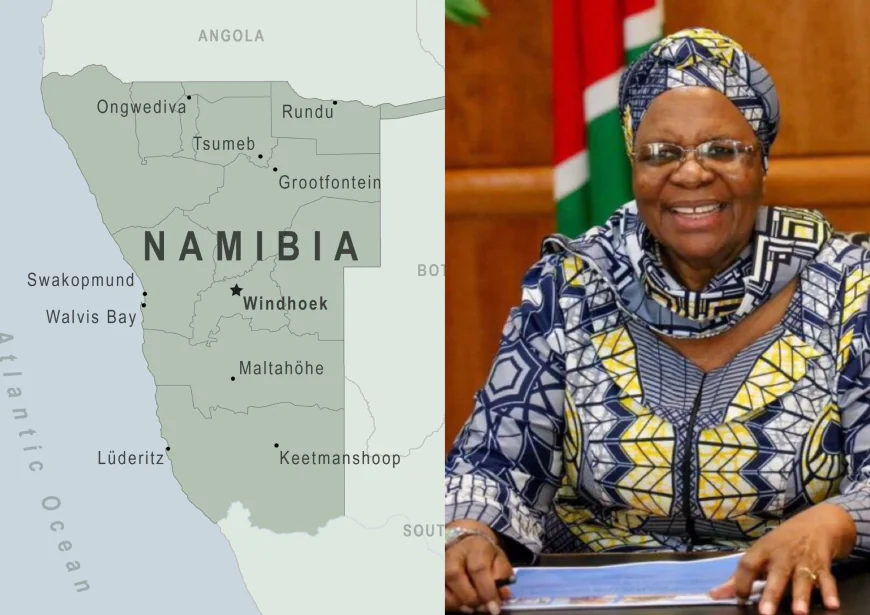Namibia’s Economy: A Larger Picture
Namibia’s economy faces multiple challenges, including high public debt, reliance on volatile mineral exports, and persistently high unemployment.

Namibia, once hailed as one of Southern Africa’s more stable economies, has faced deep-seated financial and structural challenges.
Since 2016, the nation has experienced a prolonged economic slowdown, characterised by falling commodity prices, rising debt, and persistently high unemployment.
However, President Netumbo Nandi-Ndaitwah has cleared the debt of $750M, but what does this mean for the economy and the larger picture for Namibia? Does it necessarily resolve the underlying issues and their implications for the country, its population, and international relations?
Namibia’s President Netumbo Nandi-Ndaitwah, Clears All $750M Debt in a Single Day
It will be interesting to watch the President’s actions closely to see how she tackles unemployment, the lingering implications of previous debt, and the decline in diamond prices.
According to Coface, “the budget for the two 2025-26 and 2026-27 fiscal years plans an increase in investment spending (modernisation of railways and hydraulic infrastructure projects, in particular), which should, in principle, be offset by a tightening of operational expenditures (wage bill), all aimed at curbing the deficit to less than 4% of GDP”.
With inflation, everyday goods and services become more expensive, disproportionately affecting low- and middle-income households. Rising prices undermine real wages and increase the cost of living, which can fuel social discontent and weaken consumer confidence — both key factors in slowing domestic demand.
This means that the government is spending far more than it earns while also importing substantially more than it exports—an unsustainable position that exposes the economy to external shocks and financial instability.
The high public debt initially necessitates substantial interest payments, diverting funds away from essential public services, including education, healthcare, and infrastructure development.
The previous debt level signalled that Namibia operated under high fiscal strain. The government must allocate a large share of its revenue to debt servicing rather than essential development priorities, such as education, healthcare, or infrastructure, which is another factor contributing to a reduction in fiscal flexibility.
One prediction was that a recession would occur, referring to a period of limited economic growth or contraction that lasts for several years. This reduces government revenues from taxes and exports, forcing the state to borrow more to sustain spending.
Sinking Price of Diamonds
According to the Federal Ministry for Economic Cooperation and Development (BMZ), the country has been “in ongoing recession since 2016… factors include the sinking price of diamonds and other mineral exports and a decline in industrial and agricultural production” (BMZ, 2022).
The heavy reliance on extracted commodities such as diamonds and uranium—13.3 % of GDP and 59 % of export revenues in 2024—leaves Namibia vulnerable to global commodity cycles (Coface, July 2025).
When diamond or uranium prices fall, export revenues, foreign exchange reserves, and government revenues decline sharply. This creates boom-and-bust cycles, where periods of prosperity are followed by sudden contractions, undermining long-term planning and fiscal stability.
A heavy dependence on extractive industries also raises concerns about environmental and social sustainability. Mining operations can strain water and land resources, while communities near extraction sites may face unequal distribution of benefits or displacement.
From an environmental standpoint, mining operations consume vast amounts of water and energy—both of which are scarce in Namibia’s arid climate.
The extraction of diamonds, uranium, and other minerals often requires intensive water use for processing and dust control, placing immense pressure on already limited water reserves that communities and ecosystems rely on.
On a social level, the benefits of mining are often unevenly distributed. While large multinational corporations and urban elites may profit from export revenues, local communities near mining sites frequently face displacement, loss of livelihoods, and limited access to the wealth generated from their land.

Unemployment
With industrial and agricultural production declining, job creation has stagnated, particularly in rural and youth populations.
According to the BMZ and the World Bank, Namibia’s youth unemployment rate exceeds 38%, contributing to widening inequality, poverty, and social unrest. Prolonged economic hardship erodes consumer confidence and spending, further depressing domestic demand.
Economically, these factors create a cycle of low productivity and weak domestic demand. With unemployment rates officially at 20.4% and youth unemployment as high as 38% (BMZ, 2022), a significant portion of the population lacks a stable income, which reduces consumer spending and slows business growth.
This, in turn, constrains tax revenues and limits the government’s ability to invest in infrastructure, education, and social programmes that could stimulate economic recovery.

High unemployment—particularly among young people—also represents a loss of human capital and potential innovation. When educated youth are unable to find work, skills erode, and many turn to informal or precarious jobs, further entrenching inequality. This situation can discourage further investment in education and reduce long-term competitiveness.
Socially, prolonged unemployment and economic strain contribute to rising poverty, frustration, and social unrest.
However, BMZ points to the limited capacity of the government to stimulate growth: despite a slight recovery of 0.8 % in 2021 and an anticipated 2.7 % in 2022, the strain on the budget and unemployment remain high (BMZ, May 2022).
Final Thoughts
In summary, Namibia’s economic fragility stems from a combination of structural dependence, fiscal imbalance, and social inequality.
The fall in global commodity prices has exposed the limits of a resource-driven growth model, while mounting public debt and high unemployment rates continue to strain national resilience.
Without decisive reforms to diversify the economy, strengthen human capital, and promote inclusive development, the nation risks prolonged stagnation.
Yet, with the President clearing the debt and with prudent fiscal management, investment in renewable energy and value-added industries, as well as regional trade integration, Namibia holds the potential to transform vulnerability into opportunity — paving the way toward long-term financial sustainability.



